Discovering the Secrets of Ireland’s Southwestern Coast

By Tara Austen Weaver
The man at the bike rental shop in Cork warned me against riding the Beara.
“There’s nothing there,” Mac explained, his southern Irish accent delightfully atwang. “You’ll be cycling along here,” he pointed to the map of southwestern Ireland, “and all you’ll see is gorse on one side, sea on t’other.
Then, when you get here,” he slid a callused finger down the jagged coastline, “all you’ll see is gorse on one side, sea on t’other.” Mac had worked the fishing camps that dot the peninsula. He could only see the Beara through the eyes of one who wanted to be somewhere else.
“You’d be better off cycling the Ring of Kerry or Dingle, ” he suggested, citing two peninsulas north of Beara, both more touristed. I listened to his advice but remained set in my plans.
Mac shook his head. “I don’t know why you would go to the Beara,” he said again. “There’s nothing there.”
The Beara Peninsula is one of several peninsulas reaching out like crooked fingers from southwestern Ireland into the Atlantic Ocean. It is a rugged land, regularly buffeted by storms off the Atlantic and first landfall for birds from North America who accidentally head too far east. I’ve come east as well, though not by accident, and rugged land is what I seek.
After an overload of leprechauns in Dublin’s quaint Grafton Street, and one too many tour groups in Temple Bar, I am searching for the back of beyond—but my timing may be off. After years of watching people leave her shores, tides have changed and now tourists and immigrants are flocking to Ireland in search of misty green fields and fabled friendliness. As I pack up my bike in the harbor town of Glengarriff, I wonder if this myth of Ireland can still be found.
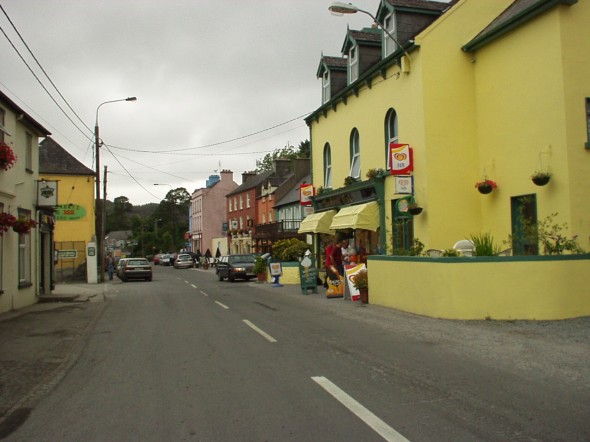
Glengarriff, a seaside resort from Victorian times, claims to have some of the best weather in Ireland—a country not known for nice weather. A series of brightly-colored shops and restaurants strung along the main road, Glengarriff serves as gateway to the Beara Peninsula. There are boats waiting offshore to ferry visitors to nearby Garnish Island where a variety of tropical plants flourish in the mild climate.
Five minutes after I leave town, it begins to rain. So much for nice weather. The Irish talk about their “soft” climate and even in August the weather is bound to turn wet. Donning a windbreaker I find it still pleasant to cycle, the fine mist cool on my face.
To my right, fog-shrouded mountains jut upward from thickets of gorse and underbrush. A clear stream flows alongside the road and I pass a pastel blue shrine dedicated to the Virgin Mary before rejoining the coast once more. From here I can see the silvery gray waters of Bantry Bay and a rugged coastline dotted with small houses tucked into rocky coves. In this wild place, the leprechauns and shamrocks of Dublin feel a million miles away.
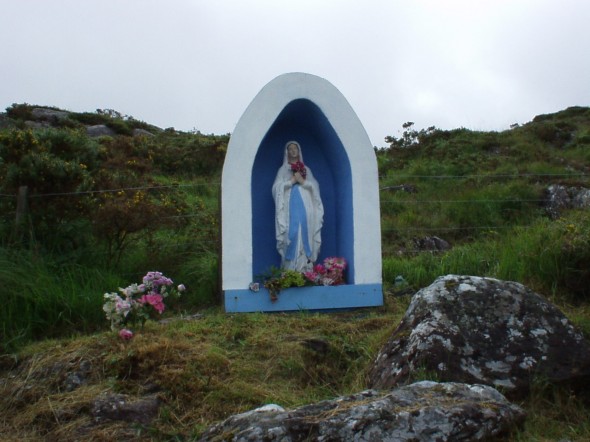
By the time I reach the small town of Adriole, I have discovered that persistent mist, given time, will prove itself the equal to any downpour. Soaked to the skin I embrace the wisdom of hot tea at a roadside teahouse, where the motherly owner fusses over me and offers fruitcake. At the combination general store and post office, the proprietor grins. “Been avoiding the rain, have ye now?” he asks as I drip water onto his well-polished floor.
The Beara Peninsula has managed to stay off the Irish tourist track due to one factor: the roads are too narrow for tour busses. Just to the north, the Ring of Kerry and Dingle Peninsula are swarmed during the summer season, small towns flooded with visitors each day.
Car tourists have discovered the Beara, however. Zooming past me on the road they stop at scenic viewpoints where one member is entrusted with the camera, sent to brave the weather and bring back a decent photo.
I have no doubt these people pity me—on my bike, in the rain. Their expression says as much. But in their rush they are missing things: the sweet smell of chamomile and honey in the air, picking wild berries from a roadside embankment dripping in dew-covered ferns, the greetings called out by old men working in the fields as I ride by. Even in the misty wet, it feels magical.
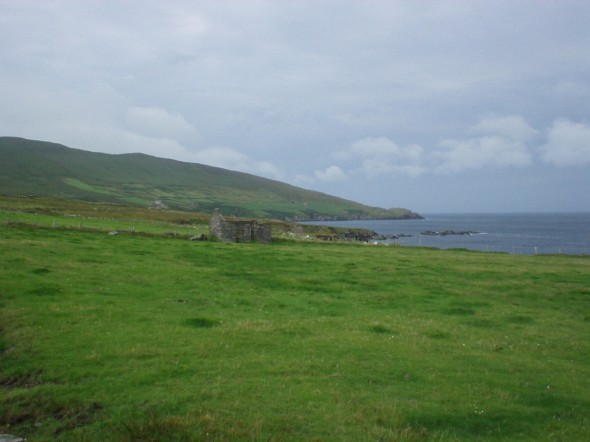
The rain continues as I push onward and into Castletownbere (full name: Castletownberehaven), 23 miles into my ride for the day. Home to Ireland’s largest fishing fleet, Castletownbere provides the restaurants of Dublin with their nightly order of whitefish. There are boats bobbing offshore and a busy waterfront to the left of the main street, but I decide my pint can wait until Allihilies at the tip of the peninsula, my goal for the night.
The truth is, I don’t want to stop biking. I love the soft air, fragrant with the smell of hay from the fields. I want to continue cycling past small white cottages, farms, and hedges of flaming red fuchsia in full bloom. I am charmed by the oncoming traffic: tractors, whose drivers tip their hats to me as we pass.
Not far past Castletownbere I see a sign for Dunboy Castle. The arched windows of the castle gatehouse are blocked with slabs of stone, vines twine over a graceful façade.
Leaving the main road, I cycle into piney woods and pay the entrance fee of a few coins to wander the impressive ruins of a stately Romanesque manor. This is not Dunboy Castle but Puxley Mansion, built in the 19th Century by a family whose wealth was drawn from copper mines on the Beara Peninsula. The mansion was gutted and burned by the IRA in 1921 during the Irish Civil War. The roof is now open to the sky and weeds sprout from cracks, but the main hallway is still flanked with Italian marble columns. Arched gothic windows, free of their panes of glass, stare blankly out to sea.
A little past Puxley Mansion lies the real Dunboy Castle—all that is left of it. Built in the 13th Century, the fortress belonged to the O’Sullivan clan who ruled the Beara for three centuries. The castle was destroyed in 1602, when the English attacked and—after 11 days of fighting—succeeded in killing all 143 men, including a priest who walked out waving a white flag of surrender. There was an attempt to rebuild the fort in 1654, but today there is little more than mossy ruins and a view across the water to Bere Island. I cycle back to the main road, past these two monuments to the Anglo-Irish conflict, destroyed more than 300 years apart.
Continuing southward I find myself at a crossroads and, minding the words of the poet, take the road less traveled—an old and narrow route that climbs into the fog.
I lose sight of the coast and am engulfed in clouds, climbing higher and higher between hedgerows of brilliant green. I hear clomping steps and, out of the mist, two children appear astride a gray horse. They nod solemnly and disappear again into the clouds, only the sound of hooves keeps me from wondering if I imagined the encounter.
I push forward, knowing the hill must eventually end. Slowly the road begins to slope and I coast downhill, gathering speed. Emerging from the clouds I can see below me a wide valley of green farms, arrayed like a verdant patchwork quilt. Nestled in the folds of the valley is the small town of Allihilies and beyond is the grey-blue sea.
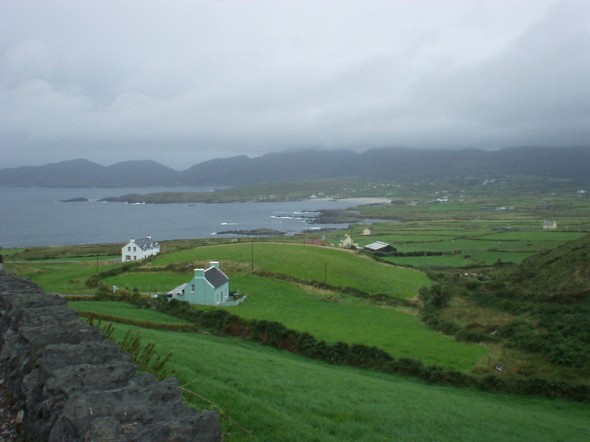
Twenty minutes later I am sitting in Jimmy’s pub, in the town of Allihilies, cheering along as Meath plays Westmeath in a televised soccer match. I have ordered a Guinness and, as a proper pint takes time to pour, am sipping hot tea and warming my hands. No one blinked an eye when I walked into the pub, damp and disheveled in my cycling clothes. It seems one must go to great lengths to shock the Irish.
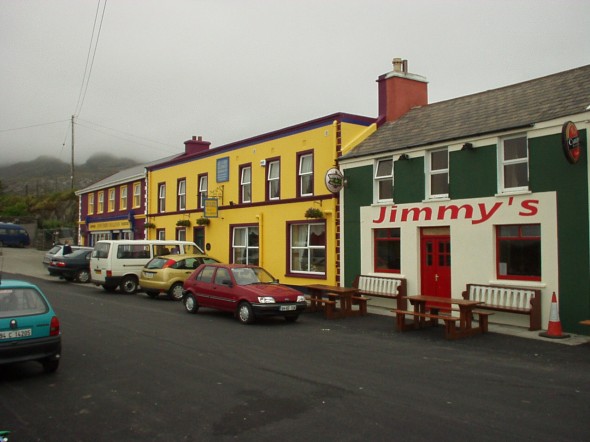
After a time my pint arrives and the deep, rich flavor is the perfect thing. As the evening progresses the pub fills with people, kids, and a dog or two until I wonder if all the town is here. The soccer game draws to an exciting conclusion, babies are passed from knee to knee, stories are told, and everyone who enters is greeted warmly. The pub is comfort, but after a full day of riding I long for sleep. I slip out of Jimmy’s and walk through the moonlit darkness to my bike. It is time for bed.
********
“Will you be having cereal, mesuli, or porridge?” Irene Harrington’s friendly face appears from behind the kitchen door.
I opt for mesuli, a decision that is greeted with an approving nod before she closes the door and I hear her rustling around the kitchen. I help myself to bracingly strong tea, fruit juice, and moist brown bread with jam.
I appeared on the doorstep of Irene Harrington’s Beach View Bed & Breakfast after my pint at Jimmy’s, having followed a hand-painted sign posted along the road. She ushered me in, gave me my choice of rooms, and seemed not at all fussed about wet gear.
Yes, she said, the bike could be locked up behind the house, breakfast was in the sunroom in the morning. One hot bath later, I drifted off to sleep next to a window that looked downhill to the beach and bay beyond. I could almost hear the waves.
I’ve eaten my fill of mesuli, tea, juice, and brown bread and am enjoying the view of green fields and clear skies when the kitchen door swings open again.
“Here ye are, a full Irish breakfast,” Irene announces, and sets before me a plate of fried eggs, bacon, grilled tomatoes, and slices of both black and white pudding.
I sit stunned, silent, without the heart to tell my hostess I’m full. Instead I try to make inroads in the huge plate of food in order to be polite. Fuel for cycling, I tell myself.
After breakfast I set out for a quick ride to the tip of the peninsula, speeding past tumbledown stone cottages and brilliant green fields. Off the end of the peninsula lies Durnsey Island, home to six people, a couple hundred sheep and cattle, and numerous shore birds.
The island is connected to the mainland by an aerial cable car, suspended 100 feet over the choppy waters of Durnsey Sound. The creaky cable car—the only one of its kind in Ireland—accommodates one cow with two calves, six tourists, or up to ten sheep at a time.
Animals take priority over humans, except on Sunday when the cable car is timed to get people to mass.
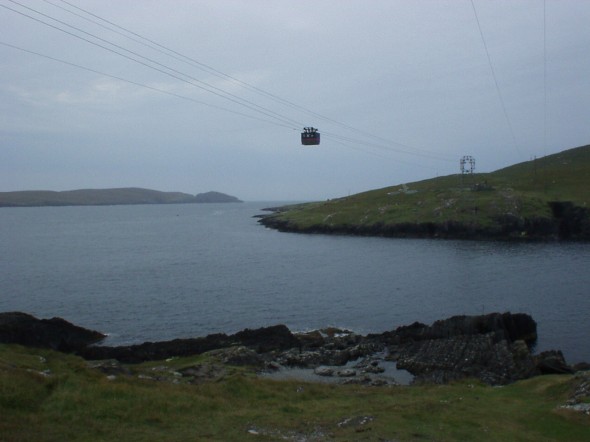
Today Durnsey Island is a sanctuary for wild birds and whales, but its past is less peaceful.
Viking marauders used the island as a base in the 9th Century to stage attacks on the coastal villages of Cork. Captives were kept on Durnsey until they could be sold into slavery in Scandinavia or Spain. Centuries later, when the English attacked Dunboy Castle, 300 people took refuge on the island. The English found them and slaughtered every last soul—women, babies and the elderly—throwing their bodies over jagged rocks to the sea below. More bloodshed in this ages-old conflict.
Turning my sights northward, I cycle up the western side of the Beara. Unlike the eastern side of the peninsula—cultivated fields and farmhouses—the west is a wilder place entirely. The road snakes over hillocks covered in brush, the wild sea lashes a rocky coastline. It is just as Mac said it would be: nothing but gorse and the sea.
He forgot, however, to mention the fierce beauty, the unparalleled views, the sense of exhilaration at being alone amongst such stunning desolation.
He forgot, also, to mention the sheep.
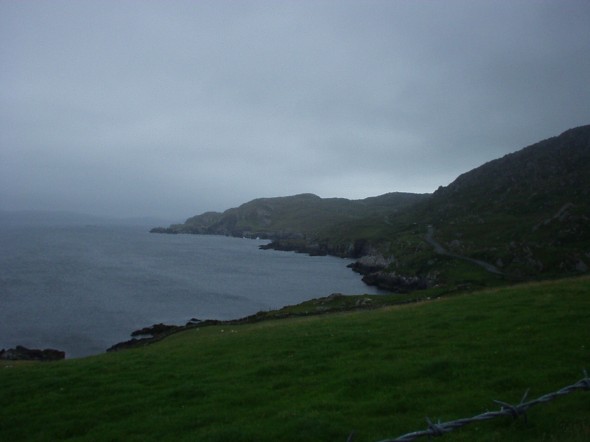
Wheeling down a hill I find the road blocked by a wooly flock. Waving my arms wildly I shout at them to “shoo,” but the sheep stand impassively before me.
I dismount and navigate my bike through the flock. It’s clear who owns the road here.
Sheep are not the only inhabitants of this remote stretch of the Beara. The ghost of history is a presence as well. Past Allihilies there are signs for a “Mass Rock,” a stone altar dating from penal times when the ruling British attempted to outlaw the Catholic faith. The Irish worshipped secretly in remote locations, posting guards to keep watch for British redcoats.
The Beara is littered with historical sites, dating back to 1,000 BC. There are stone circles, wedge tombs, and the remains of a settlement that includes stone huts and an early church surrounded by a ring fort. The next village along the western side of the peninsula is Eyeries, which boasts not only cheerful streets with houses painted every color of the rainbow, but also the tallest Ogham Stone in Ireland (17.5 feet high). Dating from the 4th to 7th centuries AD and inscribed with an early Irish script, these stones are thought to mark ancient grave sites.
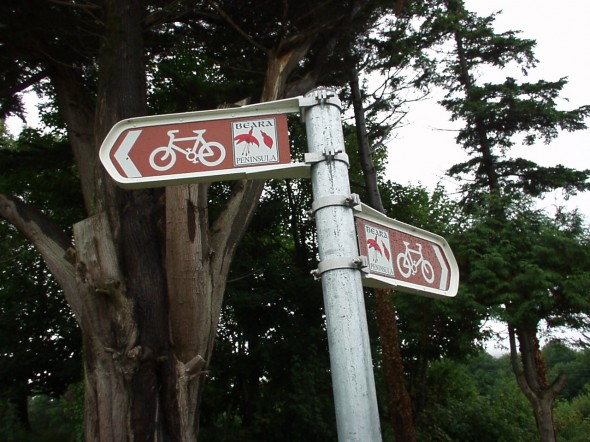
I planned to stop for lunch in the flower-bedecked town of Ardgroom, 20 hilly miles into the day, but still full from breakfast, I push through to Lauragh, located on the silvery shores of Kilmakilloge Harbor. From here the road splits and I turn right, cycling upward into the fierce rockiness of the Caha Mountains.
Here again is the desolate beauty of the Beara, sheer mountains cloaked in brush and encircled with wispy fingers of fog. Though the uphill is unrelenting, the scenery makes up for it and the air rushing past on the downhill rips my hair from beneath my helmet in a dose of pure exhilaration.
On the gray-blue shores of Clonee Lakes I come across a roadside inn. Though I am not far from Kenmare, the end of the Beara Peninsula and my goal for the night, I decide a bowl of soup is in order.
Once inside, I fall under the charge of the friendly, white-haired manager Sean. He sets me up with a bowl of steaming hot vegetable soup and more of the brown bread I have grown to love. “You’d be needing something warm after cycling that mountain, you would,” he says as he serves me.
My bowl of soup proves to be so good, and the view of Clonee Lakes so lovely, or perhaps it is Sean’s friendliness and the fact that I don’t want to leave the Beara, but I find myself asking if there might be a room available for the night.
“Ah, sure there is,” Sean replies and dons a raincoat to show how I can store my bike in a large, wood-floored hall built on the shores of the lake. “We be having dances here,” he tells me. “There was one last Friday.”
Suddenly I wish I could stay until the next dance, imaging wicked fiddle music and dancing till dawn. Truth be told, I’d be willing to stay on the Beara indefinitely.
But the next day dawns clear and the road is calling.
Having learned my lesson, I turn down cereal at breakfast and am prepared for the hefty plate of eggs, bacon, grilled tomato, sautéed mushrooms, and sausage. The dinning room staff clucks over me and tries to offer more food—fruit cocktail, toast, cereal, a variety of juices as well as tea. Breakfast, it seems, is not taken lightly in Ireland.
Packing my clothes—now clean and dry thanks to Sean—I am sad to be leaving the Beara. A few more miles and I am in the market town of Kenmare, situated along the Ring of Kerry and the end of the Beara Cycle Route. Kenmare is overwhelming, clogged with traffic, filled with tour groups, recorded Irish fiddle music broadcast from shops draped in shamrocks and green. I miss the beauty and desolation of the Beara already.
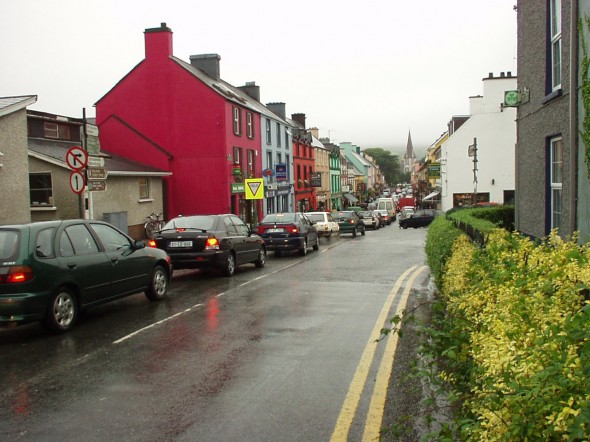
Ten days later I turn my rental bike into the bike depot in Galway. Having cycled the entire southwestern coast of Ireland—from Cork to Galway—the rugged beauty of the Beara still stands out in my mind. And I think about Mac in the bike shop and his advice to skip the Beara.
I wonder if he was truly warning me away from boring desolation, or just trying to keep the best bit of Ireland for himself. A ploy for which I wouldn’t blame him one bit.
Oh, the Beara? I wouldn’t go. There’s really nothing there.












